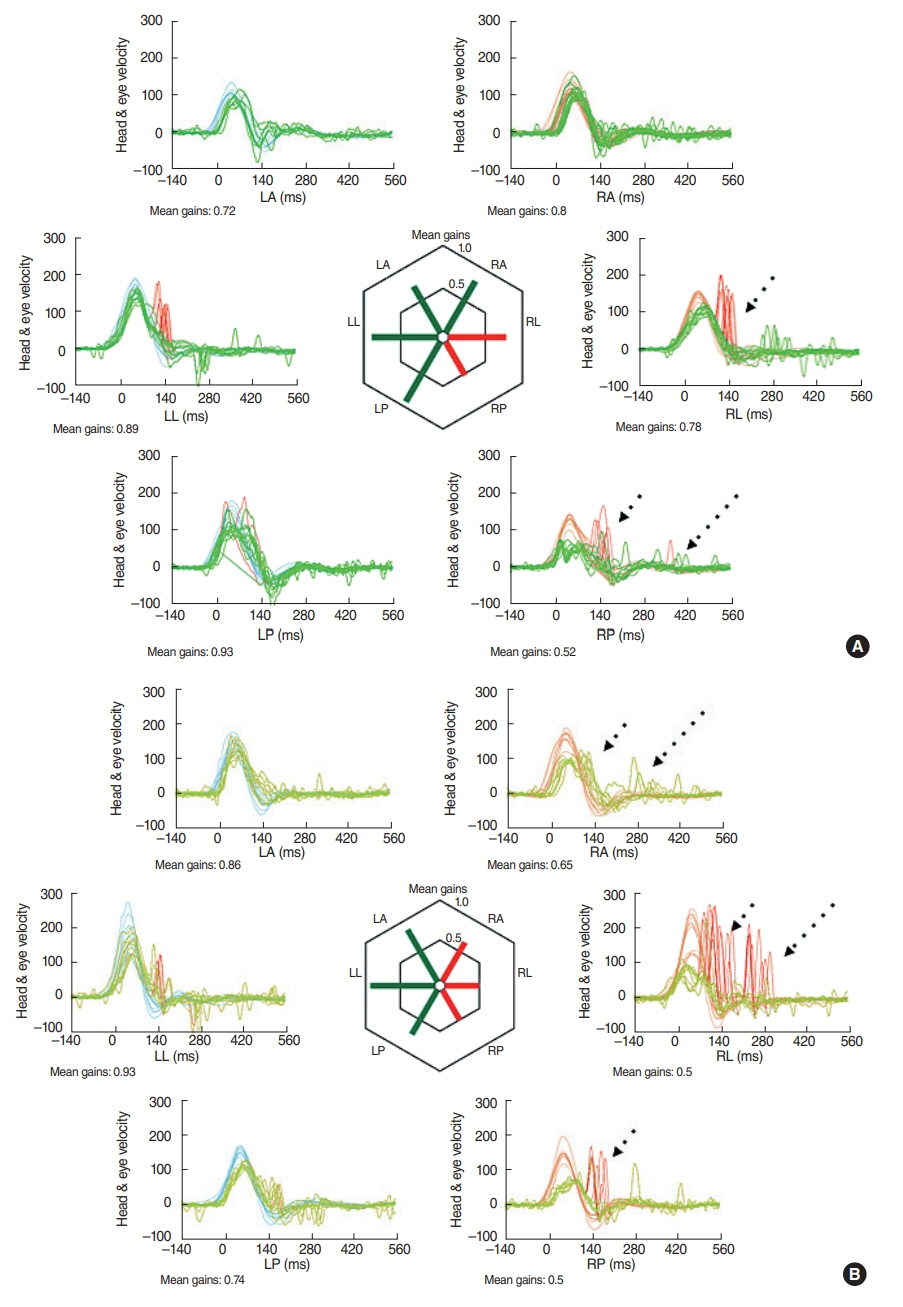Clin Exp Otorhinolaryngol.
2019 Nov;12(4):392-398. 10.21053/ceo.2018.01921.
Intratympanic Gentamicin Versus Labyrinthectomy: Inner Ear Sensitivity to Gentamicin and Impact on the Contralateral Labyrinth
- Affiliations
-
- 1Department of Otolaryngology-Head and Neck Surgery, Queen Elizabeth University Hospital, Glasgow, UK. gkontorinis@gmail.com
- KMID: 2462735
- DOI: http://doi.org/10.21053/ceo.2018.01921
Abstract
OBJECTIVES
To investigate the impact of labyrinthectomy and intratympanic (IT) gentamicin injections on the contralateral labyrinth, we also assessed the response of each individual semicircular canal to each IT gentamicin application.
METHODS
We performed a pilot observational study on tertiary, referral, academic settings. Thirteen patients with unilateral vestibular pathology were organized into two groups, group I (seven patients) receiving IT gentamicin and group II undergoing labyrinthectomy (six patients). All patients underwent six-canal video-head-impulse test in predetermined time intervals. Patients receiving gentamicin were additionally tested 3 to 5 days after every sequential injection, until all ipsilateral canals were ablated, to determine the order of response to gentamicin. We recorded the vestibular-ocular reflex gains and the presence of covert/overt saccades for each canal.
RESULTS
The posttreatment ipsilateral gains were abnormal. No patient from the gentamicin group developed abnormal contralateral responses, while patients undergoing labyrinthectomy had abnormal contralateral responses from at least one canal, even several months posttreatment. Finally, the lateral semicircular canal was the first one to be affected by IT gentamicin followed by the posterior canal: the superior canal was ablated last.
CONCLUSION
In our study, labyrinthectomy had an impact on the responses recorded from the contralateral ear, while IT gentamicin ablated the ipsilateral labyrinthine function without affecting the contralateral responses, possibly because of a milder, more gradual impact. We also show for the first time the order that IT gentamicin application affects the semicircular canals, with the lateral being the first to be affected.
MeSH Terms
Figure
Reference
-
1. Pullens B, van Benthem PP. Intratympanic gentamicin for Meniere’s disease or syndrome. Cochrane Database Syst Rev. 2011; Mar. (3):CD008234.2. Sajjadi H, Paparella MM. Meniere’s disease. Lancet. 2008; Aug. 372(9636):406–14.
Article3. Rah YC, Han JJ, Park J, Choi BY, Koo JW. Management of intractable Meniere’s disease after intratympanic injection of gentamicin. Laryngoscope. 2015; Apr. 125(4):972–8.4. Ghossaini SN, Wazen JJ. An update on the surgical treatment of Meniere’s diseases. J Am Acad Audiol. 2006; Jan. 17(1):38–44.5. Buki B, Junger H. Intratympanal gentamicin in Meniere’s disease: effects on individual semicircular canals. Auris Nasus Larynx. 2018; Feb. 45(1):39–44.
Article6. Tjernstrom F, Fransson PA, Kahlon B, Karlberg M, Lindberg S, Siesjo P, et al. Hearing and vestibular function after preoperative intratympanic gentamicin therapy for vestibular schwanomma as part of vestibular prehab. Ear Hear. 2016; Nov/Dec. 37(6):744–50.7. Marques PS, Dias CC, Perez-Fernandez N, Spratley J. Instrumental head impulse test changes after intratympanic gentamicin for unilateral definite Meniere’s disease: a systematic review and meta-analysis. Auris Nasus Larynx. 2018; Oct. 45(5):943–51.8. Ahmed RM, Hannigan IP, MacDougall HG, Chan RC, Halmagyi GM. Gentamicin ototoxicity: a 23-year selected case series of 103 patients. Med J Aust. 2012; Jun. 196(11):701–4.
Article9. Weber KP, Aw ST, Todd MJ, McGarvie LA, Curthoys IS, Halmagyi GM. Horizontal head impulse test detects gentamicin vestibulotoxicity. Neurology. 2009; Apr. 72(16):1417–24.
Article10. MacDougall HG, Weber KP, McGarvie LA, Halmagyi GM, Curthoys IS. The video head impulse test: diagnostic accuracy in peripheral vestibulopathy. Neurology. 2009; Oct. 73(14):1134–41.
Article11. Fetter M, Zee DS. Recovery from unilateral labyrinthectomy in rhesus monkey. J Neurophysiol. 1988; Feb. 59(2):370–93.
Article12. Mantokoudis G, Schubert MC, Tehrani AS, Wong AL, Agrawal Y. Early adaptation and compensation of clinical vestibular responses after unilateral vestibular deafferentation surgery. Otol Neurotol. 2014; Jan. 35(1):148–54.
Article13. Tian JR, Ishiyama A, Demer JL. Temporal dynamics of semicircular canal and otolith function following acute unilateral vestibular deafferentation in humans. Exp Brain Res. 2007; Apr. 178(4):529–41.
Article14. McCabe BF, Ryu JH, Sekitani T. Further experiments on vestibular compensation. Laryngoscope. 1972; Mar. 82(3):381–96.
Article15. Blodow A, Pannasch S, Walther LE. Detection of isolated covert saccades with the video head impulse test in peripheral vestibular disorders. Auris Nasus Larynx. 2013; Aug. 40(4):348–51.
Article16. Roehm P, Hoffer M, Balaban CD. Gentamicin uptake in the chinchilla inner ear. Hear Res. 2007; Aug. 230(1-2):43–52.
Article17. Marques P, Manrique-Huarte R, Perez-Fernandez N. Single intratympanic gentamicin injection in Meniere’s disease: VOR change and prognostic usefulness. Laryngoscope. 2015; Aug. 125(8):1915–20.18. Stevens MN, Garrison DB, Kaylie DM. What is the potential clinical utility of vHIT when assessing adult patients with dizziness. Laryngoscope. 2017; Dec. 127(12):2689–90.
Article19. Batuecas-Caletrio A, Santa Cruz-Ruiz S, Munoz-Herrera A, PerezFernandez N. The map of dizziness in vestibular schwannoma. Laryngoscope. 2015; Dec. 125(12):2784–9.
Article
- Full Text Links
- Actions
-
Cited
- CITED
-
- Close
- Share
- Similar articles
-
- Changes in Activity of Vestibular Afferents after Intratympanic Gentamicin Single Injection
- Intratympanic injection for treatment of inner ear diseases
- Effect of Dexamethasone Combination With Gentamicin in Chemical Labyrinthectomy on Hearing Preservation in Patients With Meniere’s Disease
- A Case of Tumarkin Otolithic Crisis Treated with Intratympanic Gentamicin Injection
- A Case of Tumarkin Otolithic Crisis: Failed to Treat with Intratympanic Gentamicin Injection


